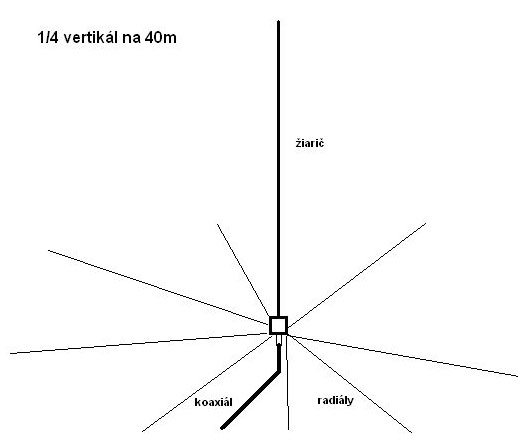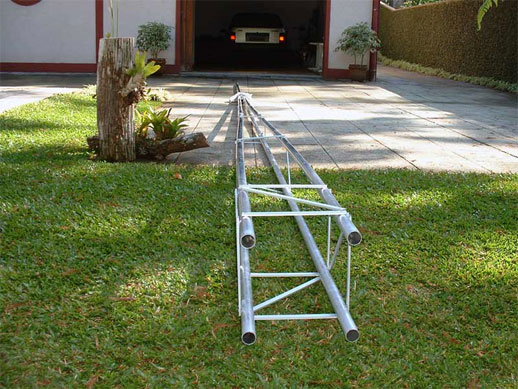Quarter-wave vertical for a band of 40m
The quarter-wave vertical is an efficient and simple antenna for the 40m band. It can be realized as a groundplane - vertical with oblique raised radials, or with ground radials. I had the opportunity to compare both versions in previous CQWW contests and there was no noticeable difference between them.
Since the height of the vertical part is about 10m, it is possible to use a telescopic rod from Jirka OK5IM for the second version of the antenna. They have a height of 12.5 m. We will not use the last two thinnest parts of them. Attach the radiator to the telescope with plastic "zippers" or insulating tape.

Sketch of a quarter-wave vertical antenna at 7MHz
From a mechanical point of view, it is appropriate to make a waterproof box - the transition between the coaxial cable and the antenna. The radials are fastened with screw clamps. An example of such a box can be seen in the photo.
The theoretical length of the radiator is 10.56 m (pre 7,1MHz). In practice, the conductor is several tens of centimeters shorter. It's caused by the team, that:
- the radials are under the box on the ground, t.j. the total length of the radiator is formed by the radiator wire + link in the box + distance of the box from the ground with laid, resp. buried radials
- due to the environment in which the antenna is located
- conductor shortening factor with insulation
- conductor thickness

To achieve compliant PSV for connection to coaxial cable without matching circuit (in which willingly or unintentionally there is always some loss), we choose only a smaller number of radials (8 to 12 according to the quality of the country). Good length is 10m, if there is no space, we try to stretch at least a few longer radials, which we supplement with a larger number of short radials.
The theoretical efficiency of the antenna is around 70%. If we increase the number of radials above one hundred(!) and used a matching circuit, we would achieve efficiency around 85%. We can improve the radiation by improving the reflecting surface around the antenna - by burying the radials. However, we do not connect them to the antenna!
To limit backflows flowing over the shield surface of the coaxial cable it is advisable to wind a few turns of the coaxial cable as a choke at the antenna supply point to a plastic bottle or other non-conductive material.
In the portable version, one person can build the antenna in a few minutes. For permanent installation, we can also make the radiator self-supporting in the form of a lattice structure mounted on insulators. An example shows a photograph.

Bar construction of a quarter-wave antenna at 7MHz
Increasing the gain and obtaining directional effects is possible by pressing, for example, four antennas. However, it is a more complex system to make - four identical antennas, phasing lines, relay, switch with direction indicator, power supply, etc..
The quarter-wave vertical is a simple and good antenna - give it a try!



